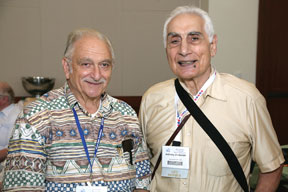It was difficult to pick one EMC war story out
of literally hundreds. But this story has a very interesting twist.
It relates to solving a problem on the Grumman-built US Navy E-2A
aircraft that hampered its early flight developmental testing
at Grumman’s Bethpage, Long Island, New York airport. The
aircraft’s Avionics Flight Test Engineer, Bill, reported
that the problem was caused by radio interference in the LF/ADF
(Low Frequency/Automatic Direction Finder) radio. This interference
limited aircraft flights to within five miles of the airport;
thus, precluding flights at the longer distances needed for developmental
testing. (The maximum range of that radio is about 100 miles.).
Furthermore, Bill reported that the EMI engineers didn’t
know how to solve the problem. Subsequently, I discovered his
bias against EMI personnel.
Summarily, in late 1960, several months after hiring into Grumman
to work on the A-6A aircraft, my supervisor directed me to investigate
and develop a solution for the reported problem. A flight test
was scheduled on “Christmas Bonus Day.” I appeared
at the flight ready room, met Bill, and asked “What now?”
He said, “Harness up.”
I replied, “Show me how, and what do I do if we have to
use the parachute?” (This is part of the harness for those
who are not familiar.)
He said, “You mean you haven’t been to school and
been certified to fly?”
I noticed that he had a wry smile on his face and he said, “You’re
going to fly any way.”
So, he harnessed me up and as we walked towards the aircraft Bill
briefed me on aircraft ejection procedures.
The E-2A aircraft has a left and right engine, a forward compartment
for the pilot and co-pilot, and an aft compartment for three radar
operational personnel. On this flight I occupied the rear most
seat and the flight test engineer was seated adjacently. The E-2A
took off and I completed my test. Then the pilot announced that
we had time to conduct “a fish-tail experiment.” (Fish-tailing
causes aircraft movement from side to side.) Since maximum movement
would be experienced by the occupant of the rearmost seat, the
pilot requested that I report my observations as he stopped, in
turn, the left and right engines. In so doing, my mind became
preoccupied with “If we ditch, do I eject or not? Who’s
going to pick up my bonus check?” We didn’t ditch,
returned to the airport and assembled in the debrief room to audio
tape our observations. I reported that my test results revealed
that the limited range of the LF/ADF radio was not due to interference
but to inadequate antenna performance. The flight test engineer
reported that the test proves that it was an interference problem.
We were back to square one. The controversy persisted until I
convinced the Chief E-2A Test Pilot, Tommy, to make a flight with
a “jury-rigged” antenna installed per my recommendation
about six inches below the aircraft’s fuselage.
Several days later, Tommy took off with the jury-rigged antenna
while the ground crew and I monitored the flight. Tommy flew out
to five miles, then to ten miles and then finally reported that
he is over 100 miles away. Tommy returned, landed and proceeded
to say, “If anybody tries to take that antenna off, I will
exercise my prerogative.”
Everybody knew what that meant. As did each of the chief test
pilots of Grumman aircraft: he is authorized to phone the CEO.
Thus, the developmental flight test continued with a rigged antenna.
Meanwhile, the E-2A, Antenna, and Avionics Flight engineers were
still arguing that it was not an antenna problem. Their basis
was that I had moved the antenna away from the interference source
by bringing it outside the airplane.
I said, “You are wrong and the E-2A EMC Group will perform
testing to so prove.”
Meanwhile, my Section Chief directed me to develop a test plan
and a mathematical model to prove my contention, as well as to
oversee the testing and lead discussions on resolving the conflicting
views. In so doing, I read the antenna installation manual that
recommended a minimum fuselage aperture size. However, the actual
size was well below the minimum.
My discussions with Bill, the antenna engineer, revealed that
he had approved downsizing the aperture because the Structural
Engineering department had so requested and that the antenna manufacturer
had so approved. I told Bill about the upcoming antenna test whose
purpose was to measure antenna performance.
That testing was performed, which required monitoring the signal
levels received by the antenna while it was lowered, one inch
at a time, from its installed location inside the fuselage until
it was six inches below the fuselage. The test results validated
the mathematical model that showed that the received signal would
increase and peak at about four inches below the fuselage.
After Bill reviewed that data, he endorsed a permanent antenna
in a radome below the aircraft’s fuselage.
Epilogue: After my “Christmas Bonus Day”
flight, I collected my bonus check and on my next pay cycle, I
noticed that my pay had been increased. Subsequently, I was assigned
as the E-2A EMC Group Leader. To this day, 47 years later, that
antenna sits two inches below the fuselage of the latest version
of the E-2 aircraft.
Editor’s Note: The author of last issue’s
“War Story”, Vincent Mancino, was incorrectly identified
in the photo accompanying the story. EMC Founders Vincent Mancino
(left) and Anthony Zimbalatti (right) are correctly shown above.
EMC
 EMC
War Stories
EMC
War Stories